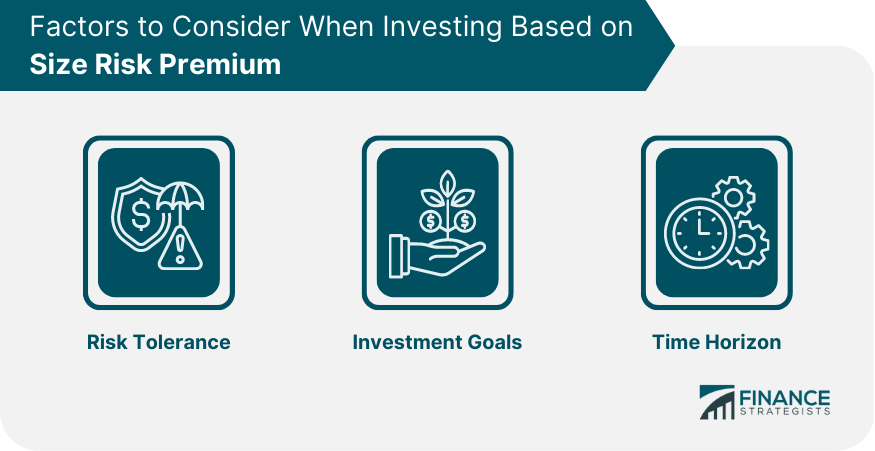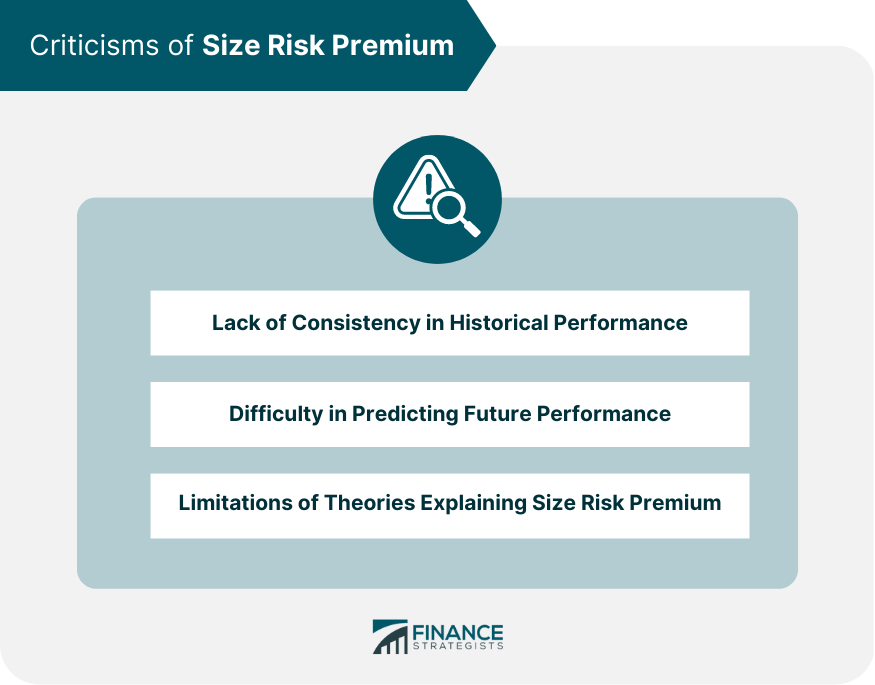Size risk premium is the additional return that investors expect to earn by investing in small-cap stocks compared to large-cap stocks. Small-cap stocks are generally riskier than large-cap stocks, and therefore, investors demand a higher return to compensate for the additional risk. The size risk premium is the compensation investors receive for investing in small-cap stocks, which have historically outperformed large-cap stocks over the long-term. The size risk premium is an important factor to consider when making investment decisions and constructing investment portfolios. Market risk, also known as systematic risk, is the risk that affects the entire stock market. Market risk is influenced by macroeconomic factors such as inflation, interest rates, and political stability. Small-cap stocks are more volatile than large-cap stocks due to their exposure to market risk. This increased volatility translates into higher returns, which can be considered as compensation for the higher risk. Liquidity risk is the risk that an investor may not be able to sell their securities quickly or at a fair price. Small-cap stocks are less liquid than large-cap stocks, and investors may face challenges in finding buyers when selling their securities. The higher liquidity risk associated with small-cap stocks results in investors demanding a higher return, which is the size risk premium. Volatility risk is the risk that a security's price will fluctuate significantly in a short period. Small-cap stocks have higher volatility than large-cap stocks, resulting in higher returns. This higher volatility can be attributed to the limited resources available to small-cap companies, making them more vulnerable to market movements. Firm-specific risk is the risk that affects a particular company or industry. Small-cap companies are more exposed to firm-specific risks than large-cap companies. This exposure to risk results in higher expected returns, which are reflected in the size risk premium. The size risk premium has been observed in the historical performance of small-cap stocks compared to large-cap stocks. Small-cap stocks have outperformed large-cap stocks over the long-term, resulting in higher returns. The returns earned by small-cap stocks are attributed to the size risk premium, which is the additional compensation investors demand for investing in small-cap stocks. Several factors have contributed to the historical performance of the size risk premium. Economic conditions such as low-interest rates, high economic growth, and low inflation have resulted in higher returns for small-cap stocks. Investor sentiment, such as a preference for high-risk investments, has also contributed to the historical performance of the size risk premium. Market trends such as technological advancements, which favor small-cap companies, have also contributed to the performance of the size risk premium. Modern Portfolio Theory (MPT) was developed by Harry Markowitz in 1952. MPT is a framework for constructing investment portfolios that maximize returns for a given level of risk. MPT assumes that investors are risk-averse and seek to maximize returns while minimizing risks. MPT suggests that the size risk premium exists because small-cap stocks are riskier than large-cap stocks, resulting in higher returns. The Fama-French Three-Factor Model was developed by Eugene Fama and Kenneth French in 1992. The model seeks to explain the returns of stocks based on three factors: market risk, size, and value. The size factor represents the size risk premium, which is the excess return earned by investing in small-cap stocks compared to large-cap stocks. The Fama-French model suggests that the size risk premium exists because small-cap stocks are riskier than large-cap stocks, and investors demand a higher return for taking on the additional risk. Behavioral finance theory suggests that investors' behavior influences their investment decisions. It posits that investors' cognitive biases, such as overconfidence and herd mentality, can lead to irrational investment decisions. According to this theory, the size risk premium exists because investors have a preference for high-risk investments, such as small-cap stocks. Investment strategies based on size risk premium involve investing in small-cap stocks to earn higher returns than large-cap stocks. Small-cap stocks are typically riskier than large-cap stocks, and investors demand a higher return to compensate for the higher risk. Value investing involves investing in stocks that are undervalued by the market. Value investors typically invest in small-cap stocks that are overlooked by the market, resulting in undervaluation. Value investors believe that the market will eventually recognize the true value of the stocks, resulting in higher returns. Growth investing involves investing in stocks that are expected to grow at a faster rate than the market. Growth investors typically invest in small-cap stocks that have high growth potential. Growth investors believe that the growth potential of small-cap stocks will result in higher returns. Investing based on size risk premium involves considering several factors. Risk tolerance is an essential factor to consider when investing based on size risk premium. Investors with a high-risk tolerance are more likely to invest in small-cap stocks than investors with a low-risk tolerance. Investment goals, such as long-term growth or short-term gains, are also essential factors to consider when investing based on size risk premium. Time horizon is another essential factor to consider when investing based on size risk premium. Investors with a long-term time horizon are more likely to invest in small-cap stocks than investors with a short-term time horizon. The historical performance of the size risk premium has not been consistent. There have been periods where small-cap stocks have underperformed large-cap stocks, resulting in lower returns. This lack of consistency in historical performance has led some investors to question the existence of the size risk premium. Predicting the future performance of the size risk premium is challenging. The performance of small-cap stocks is influenced by several factors, such as economic conditions, market trends, and investor sentiment, which are difficult to predict. The difficulty in predicting future performance has led some investors to avoid investing in small-cap stocks. The theories explaining the size risk premium have limitations. MPT assumes that investors are rational and do not have cognitive biases, which is not always the case. The Fama-French model assumes that the size risk premium exists because small-cap stocks are riskier than large-cap stocks, which may not always be the case. Behavioral finance theory assumes that investors have cognitive biases that influence their investment decisions, which may not always be the case. Investing in the stock market involves risk, and investors are faced with the dilemma of investing in small or large-cap stocks. The size risk premium is the additional return investors expect to earn by investing in small-cap stocks compared to large-cap stocks. Small-cap stocks have historically outperformed large-cap stocks, resulting in higher returns. The size risk premium exists because small-cap stocks are riskier than large-cap stocks, resulting in higher returns. The theories explaining the size risk premium, such as Modern Portfolio Theory, the Fama-French Three-Factor Model, and Behavioral Finance Theory, have limitations. Investing based on size risk premium involves considering several factors such as risk tolerance, investment goals, and time horizon. Although the historical performance of the size risk premium has not been consistent, the size risk premium remains an important factor to consider when making investment decisions. Investors should consider the benefits and drawbacks of investing in small-cap stocks and evaluate their investment goals and risk tolerance before investing in small-cap stocks. The size risk premium is an important aspect of the stock market that investors should consider when constructing their investment portfolios.What Is Size Risk Premium?
Factors Influencing Size Risk Premium
Market Risk
Liquidity Risk
Volatility Risk
Firm-Specific Risk
Historical Performance of Size Risk Premium
Small-Cap vs Large-Cap Stocks
Factors Contributing to Historical Performance
Theories Explaining Size Risk Premium
Modern Portfolio Theory
Fama-French Three-Factor Model
Behavioral Finance Theory
Application of Size Risk Premium
Investment Strategies Based on Size Risk Premium
Value Investing
Growth Investing
Factors to Consider When Investing Based on Size Risk Premium
Risk Tolerance
Investment Goals
Time Horizon

Criticisms of Size Risk Premium
Lack of Consistency in Historical Performance
Difficulty in Predicting Future Performance
Limitations of Theories Explaining Size Risk Premium

Conclusion
Size Risk Premium FAQs
Several factors contribute to the size risk premium, including market risk, liquidity risk, volatility risk, and firm-specific risk. Small-cap stocks are generally riskier than large-cap stocks and therefore, demand a higher return.
Investment strategies that incorporate size risk premium include value investing and growth investing. Value investors look for undervalued small-cap stocks, while growth investors look for small-cap stocks with high growth potential.
The size risk premium has historically outperformed large-cap stocks over the long-term, but it is not a reliable indicator of future returns. The future performance of small-cap stocks is influenced by several factors, such as economic conditions, market trends, and investor sentiment.
Investors can use the size risk premium to make investment decisions by considering their risk tolerance, investment goals, and time horizon. Investors with a high-risk tolerance and a long-term time horizon may choose to invest in small-cap stocks to earn higher returns. However, investing in small-cap stocks involves higher risks, and investors should evaluate their investment goals and risk tolerance before making investment decisions.
Yes, investing in small-cap stocks based on size risk premium involves higher risks, and investors may face challenges in finding buyers when selling their securities. The historical performance of the size risk premium has not been consistent, and investors may face difficulty in predicting future performance.
True Tamplin is a published author, public speaker, CEO of UpDigital, and founder of Finance Strategists.
True is a Certified Educator in Personal Finance (CEPF®), author of The Handy Financial Ratios Guide, a member of the Society for Advancing Business Editing and Writing, contributes to his financial education site, Finance Strategists, and has spoken to various financial communities such as the CFA Institute, as well as university students like his Alma mater, Biola University, where he received a bachelor of science in business and data analytics.
To learn more about True, visit his personal website or view his author profiles on Amazon, Nasdaq and Forbes.















